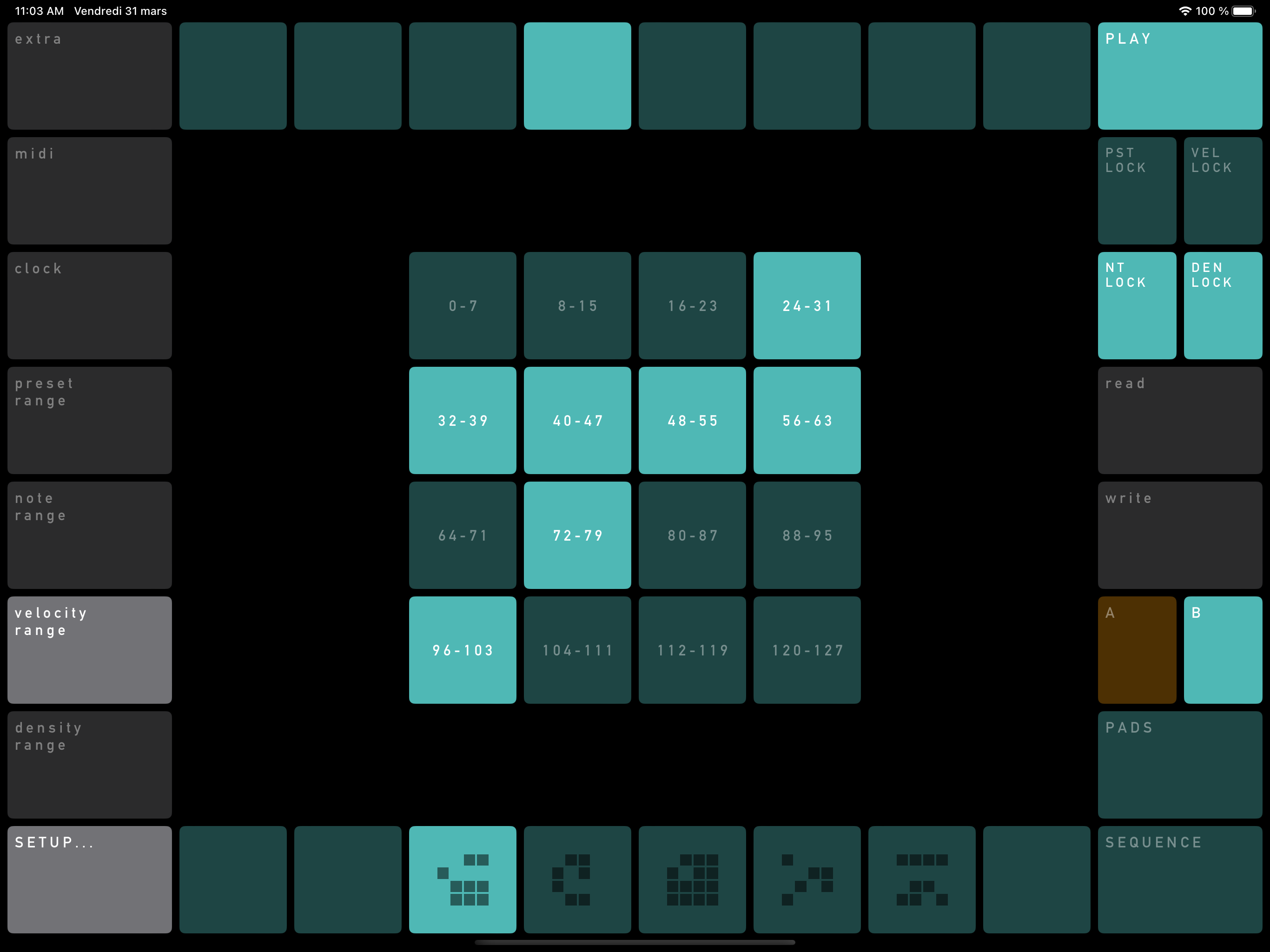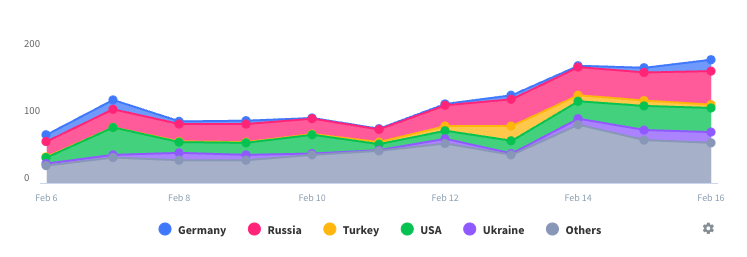
Description
sqsl Puzzle is a conceptual MIDI sequencer and controller for iPad. Interface is composed of central zone and switching controls placed around the edges. Central zone can display playable pads, sequencer, read/write positions (presets saving) and various setup parameters.
Pads:
There are 12 pads with assignable program, pitch, velocity and density (probability) - when pad is touched, note message is sent out preceded by program change message (it will change preset on target devices that support it - eg. hardware mono-synths with presets). Alternatively, MIDI channels or CC value can be assigned instead of programme changes, in that case pads will be sending notes on different MIDI channels or send new CC value.
Pad parameters (program, pitch, velocity, density) can by adjusted manually by sliding vertically on the pad area or can be assigned randomly by tapping on pad when RANDOM is active. Range from which random values are selected can be limited in setup.
There are 8 switchable “pad pages”, each containing assignments for 12 pads - pad pages are selected using coloured buttons around the top edge. Parameter(s) of all 12 pads on the page can be randomised (within range specified in setup) by tapping on already active pad page button.
Sequencer:
Pads can be sequenced by single-track (monophonic) internal sequencer inspired by wave interference rhythm theory of Joseph Schillinger. Sequencer is running through 16 positions. Pads are assigned to positions 1-12 by default, positions 13-16 result in silence/no notes sent out. This pad-position assignment can be changed using offset parameter found on sequencer page.
Sequence (order in which 16 positions are accessed) is based on 4 counters (A, B, C, D) running from 15 or less to zero. Each counter has its “resulting value”, which can be 0 or 1, 2, 4, 8 (respectively for A, B, C, D) and sum of all counters resulting values defines current sequence position (pad). When counter’s count is not zero, it’s resulting value is zero. When count is 0, resulting value is 1 for A, 2 for B, 4 for C and 8 for D counter.
Sequencer/counters length setting is accessed by tapping on SEQUENCE button. There are 6 columns of 4 buttons. First column defines offset of pads/sequencer position assignment. Coloured 4 columns in center define counters lengths. Last column defines loop length of current sequence - number of steps after which all the counters are reset (each button counting for 16 steps). If no loop length is set, counters will not reset and the sequence will repeat naturally.
Offset and counter lengths buttons are defined by state of 4 buttons: upper buttons counts for 1, second for 2, third for 4 and last for 8. Sum of active buttons gives the actual parameter value.
Similar to pad pages, there are 8 sequencer pages (buttons around the bottom edge) that can be used to momentarily store sequences and switch through them. Tapping on already active page when RANDOM is active, results in randomisation of counters lengths (new sequence).
A/B Layer:
There are 2 layers (orange and teal color) each with separate pads and sequencer slot settings. Layer B can be synchronised to follow BPM of layer A or run independently.
Setup:
General parameters (per layer): MIDI Output, MIDI channel, BPM, swing, clock division, clock density (probability of clock pulse being randomly ignored). Randomisation parameters: preset, semitone/octave, velocity and density range.
Read/Write:
There are 8 pages each with 56 positions where current slots and settings of all pads and sequencer slots can be saved. Read/write action can be used without stopping playback and read operation can be set in setup to affect only to single (current) layer.
—
Visual description of all controls can be found at https://www.seqsual.com/puzzle
—
Limitations
Standalone app (no AUv3), does not produce any sound on its own and is not recommended for iPad Mini (controls become too small).
Hide
Show More...
Pads:
There are 12 pads with assignable program, pitch, velocity and density (probability) - when pad is touched, note message is sent out preceded by program change message (it will change preset on target devices that support it - eg. hardware mono-synths with presets). Alternatively, MIDI channels or CC value can be assigned instead of programme changes, in that case pads will be sending notes on different MIDI channels or send new CC value.
Pad parameters (program, pitch, velocity, density) can by adjusted manually by sliding vertically on the pad area or can be assigned randomly by tapping on pad when RANDOM is active. Range from which random values are selected can be limited in setup.
There are 8 switchable “pad pages”, each containing assignments for 12 pads - pad pages are selected using coloured buttons around the top edge. Parameter(s) of all 12 pads on the page can be randomised (within range specified in setup) by tapping on already active pad page button.
Sequencer:
Pads can be sequenced by single-track (monophonic) internal sequencer inspired by wave interference rhythm theory of Joseph Schillinger. Sequencer is running through 16 positions. Pads are assigned to positions 1-12 by default, positions 13-16 result in silence/no notes sent out. This pad-position assignment can be changed using offset parameter found on sequencer page.
Sequence (order in which 16 positions are accessed) is based on 4 counters (A, B, C, D) running from 15 or less to zero. Each counter has its “resulting value”, which can be 0 or 1, 2, 4, 8 (respectively for A, B, C, D) and sum of all counters resulting values defines current sequence position (pad). When counter’s count is not zero, it’s resulting value is zero. When count is 0, resulting value is 1 for A, 2 for B, 4 for C and 8 for D counter.
Sequencer/counters length setting is accessed by tapping on SEQUENCE button. There are 6 columns of 4 buttons. First column defines offset of pads/sequencer position assignment. Coloured 4 columns in center define counters lengths. Last column defines loop length of current sequence - number of steps after which all the counters are reset (each button counting for 16 steps). If no loop length is set, counters will not reset and the sequence will repeat naturally.
Offset and counter lengths buttons are defined by state of 4 buttons: upper buttons counts for 1, second for 2, third for 4 and last for 8. Sum of active buttons gives the actual parameter value.
Similar to pad pages, there are 8 sequencer pages (buttons around the bottom edge) that can be used to momentarily store sequences and switch through them. Tapping on already active page when RANDOM is active, results in randomisation of counters lengths (new sequence).
A/B Layer:
There are 2 layers (orange and teal color) each with separate pads and sequencer slot settings. Layer B can be synchronised to follow BPM of layer A or run independently.
Setup:
General parameters (per layer): MIDI Output, MIDI channel, BPM, swing, clock division, clock density (probability of clock pulse being randomly ignored). Randomisation parameters: preset, semitone/octave, velocity and density range.
Read/Write:
There are 8 pages each with 56 positions where current slots and settings of all pads and sequencer slots can be saved. Read/write action can be used without stopping playback and read operation can be set in setup to affect only to single (current) layer.
—
Visual description of all controls can be found at https://www.seqsual.com/puzzle
—
Limitations
Standalone app (no AUv3), does not produce any sound on its own and is not recommended for iPad Mini (controls become too small).
Screenshots
sqsl Puzzle FAQ
-
Is sqsl Puzzle free?
Yes, sqsl Puzzle is completely free and it doesn't have any in-app purchases or subscriptions.
-
Is sqsl Puzzle legit?
Not enough reviews to make a reliable assessment. The app needs more user feedback.
Thanks for the vote -
How much does sqsl Puzzle cost?
sqsl Puzzle is free.
-
What is sqsl Puzzle revenue?
To get estimated revenue of sqsl Puzzle app and other AppStore insights you can sign up to AppTail Mobile Analytics Platform.

User Rating
App is not rated in France yet.

Ratings History
sqsl Puzzle Reviews
Store Rankings

Ranking History
App Ranking History not available yet

Category Rankings
App is not ranked yet
sqsl Puzzle Competitors
| Name | Downloads (30d) | Monthly Revenue | Reviews | Ratings | Recent release | |
|---|---|---|---|---|---|---|
|
SynthJacker
Sample your synths with ease
|
Unlock
|
Unlock
|
2
|
|
2 years ago | |
|
Tails - Dual Reverb
by Unfiltered Audio and BT
|
Unlock
|
Unlock
|
0
|
|
1 year ago | |
|
Electrogene
|
Unlock
|
Unlock
|
0
|
|
9 months ago | |
|
TfxMod
TimeFX Chorus / Flanger
|
Unlock
|
Unlock
|
0
|
|
1 year ago | |
|
Musing B Module
Customizable Musical Interface
|
Unlock
|
Unlock
|
0
|
|
2 years ago | |
|
SWAM Trumpet C
Expressive Modeled Brass
|
Unlock
|
Unlock
|
0
|
|
1 month ago | |
|
keyboaredo
microtonal (EDO) MIDI keyboard
|
Unlock
|
Unlock
|
0
|
|
2 years ago | |
|
Eternal Flow Dub
generative music player
|
Unlock
|
Unlock
|
0
|
|
1 year ago | |
|
TimeVerb-X
Spring Reverb + Digital Reverb
|
Unlock
|
Unlock
|
0
|
|
9 months ago | |
|
GSDSP MagicFusion
Spectral Vocoder AUv3
|
Unlock
|
Unlock
|
0
|
|
2 weeks ago |
sqsl Puzzle Installs
Last 30 dayssqsl Puzzle Revenue
Last 30 dayssqsl Puzzle Revenue and Downloads
Gain valuable insights into sqsl Puzzle performance with our analytics.
Sign up now to access downloads, revenue, and more.
Sign up now to access downloads, revenue, and more.
App Info
- Category
- Music
- Publisher
- Michal Macura
- Languages
- English
- Recent release
- 1.1 (1 year ago )
- Released on
- Apr 3, 2023 (1 year ago )
- Also available in
- India, South Africa, Vietnam, Thailand, Singapore, Saudi Arabia, Russia, Pakistan, Peru, New Zealand, Malaysia, Mexico, Lebanon, Kuwait, South Korea, Japan, United Arab Emirates, Indonesia, Greece, United Kingdom, France, Egypt, Ecuador, Dominican Republic, Germany, Colombia, China, Chile, Switzerland, Canada, Brazil
- Last Updated
- 3 weeks ago





